Greenworks GPW1501 review: a solid budget-friendly electric pressure washer
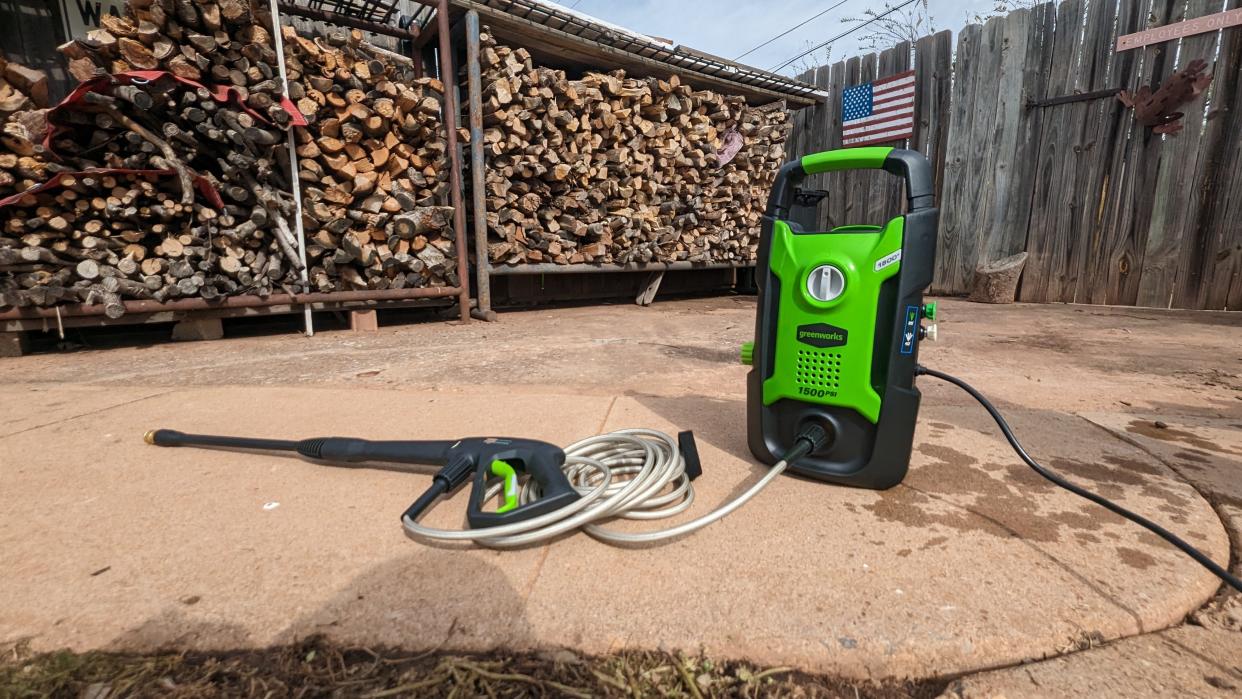
When cleaning and maintaining your home, most people want a pressure washer that’s easy to move around, will clean tough surfaces, and isn’t too expensive. We’ve found that in the Greenworks GPW1501 1500 PSI 1.2 GPM Pressure Washer. Our tester had never used an electric pressure washer, so she was excited to get her hands on one, especially since her concrete patio was looking a little worse for wear.
While the pressure washer has a low-to-average PSI and GPM rating, our tester was surprised by how well it removed algae, moss, dirt, mud, and grime from concrete, brick, wood, and plastic. While this lightweight and easy-to-use pressure washer may have a few drawbacks, for the most part, it does the trick for average pressure washing needs.
Keep reading to better understand how the Greenworks GPW1501 1500 PSI 1.2 GPM Pressure Washer handles different jobs. If you have time, take a look at our best pressure washers guide.
Greenworks GPW1501 Pressure Washer: Design
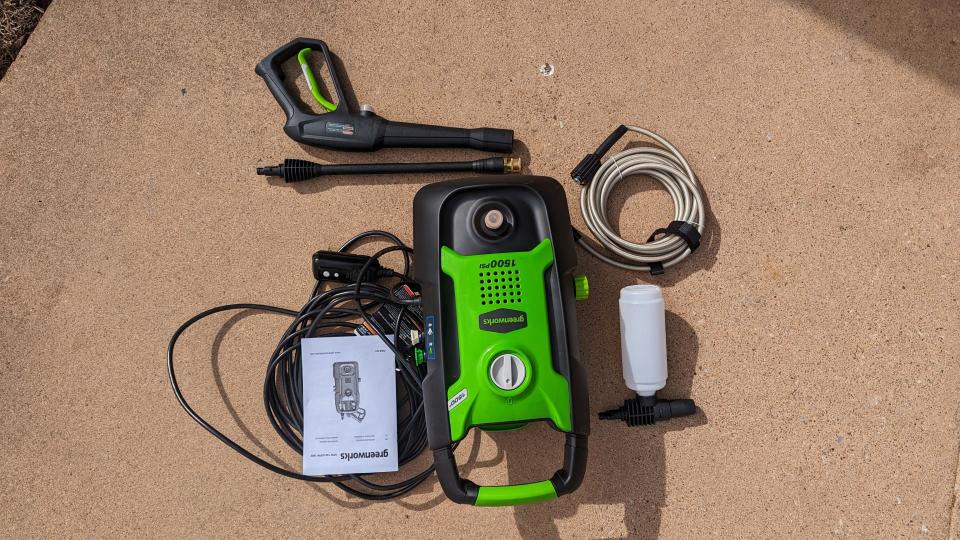
The Greenworks GPW1501 1500 PSI 1.2 GPM pressure washer is a compact plastic, green, and black pressure washer. It’s essentially the size of a backpack, weighs 17 lbs., and is super easy to carry around thanks to a top handle. This particular model did not have wheels. The turbo nozzle is not particularly long or short, but it is a nice average length and lightweight.
At the bottom of the pressure washer is where you connect the hose to the turbo nozzle. A connector for the garden hose is on the side. On the opposite side are where the two quick connect tips are stored. The electric cord is below those tips and is 35 feet long; the nozzle hose is 20 feet.
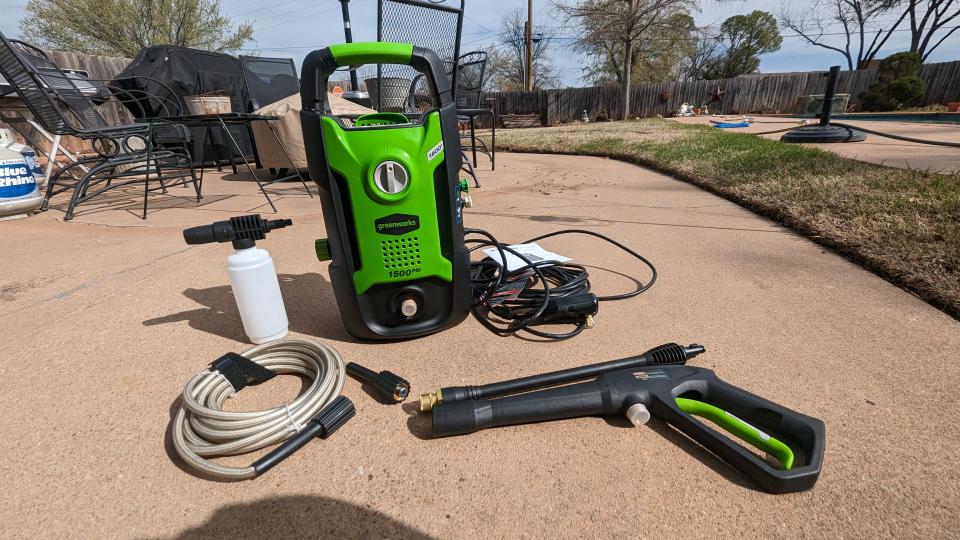
The back of the pressure washer has a little basket. While you can’t place the soap dispenser bottle in the basket, you can store the turbo nozzle or the rolled-up cord and hose if they’re wrapped tightly.
Remember that upon first use, the hose is a tight spiral shape because of how it is packaged. You’ll need to stretch the hose out straight for the first few uses to make it easier to use. At times, the hose and cord got tangled during our testing, and it took some effort to detangle it.
Greenworks GPW1501 Pressure Washer: Features
Let's break down the features to understand better how the Greenworks GPW 1501 1500 PSI 1.2 GPM pressure washer works. The spray wand has a safety lock so you can lock the trigger in place, so it doesn’t spray when you’re not using the pressure washer. However, this seems unnecessary for the most part. It would have been better if the pressure washer had a trigger lock so you could ‘lock’ the trigger and not have to hold it constantly, which puts pressure on your wrists and hands over time.
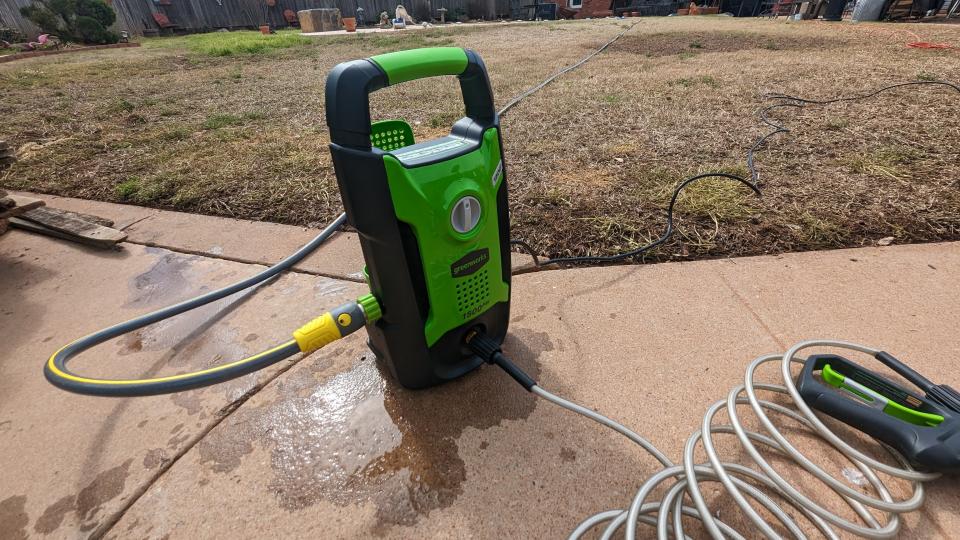
This pressure washer comes with two quick connect tips. The narrow tip emits a 25-degree spray, while the wide fan tip is 40 degrees. You typically use the wide fan tip to remove debris or clean a wide area. It emits a lower fan spray than the narrow tip. We used the narrow tip for the toughest jobs. A soap bottle is included with this pressure washer, but you’ll have to install it when you want to cover something with soap and then remove it to use water only.
Perhaps the most important features of this pressure washer are the PSI and the GPM. A 1500 PSI and 1.2 GPM are average to low-average when we compare them to other pressure washers. While they can handle most household cleaning chores and won’t strip paint from wood or your car, you’ll find that the cleaning job may take a little longer to complete. There isn’t enough pressure or output provided with this pressure washer to get a job done super fast.
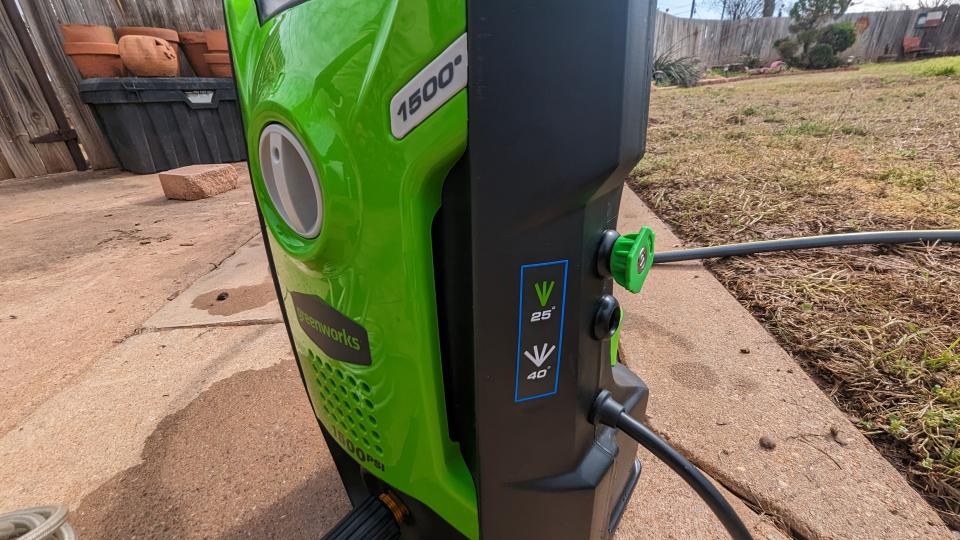
Greenworks GPW1501 Pressure Washer: Setup
This pressure washer came inside a medium cardboard box that we could recycle. An instructional pamphlet was provided, although it wasn’t necessary for a single person to assemble the pressure washer. Setting up the pressure washer is fairly logical. All it took was unfurling the hose and straightening it out before attaching it to the pressure washer, followed by attaching the garden hose to the side of the machine. From there, we fit the two parts of the spray wand by putting them together and turning one part of the nozzle until it clicked in place. The hose connected to the bottom of the wand.
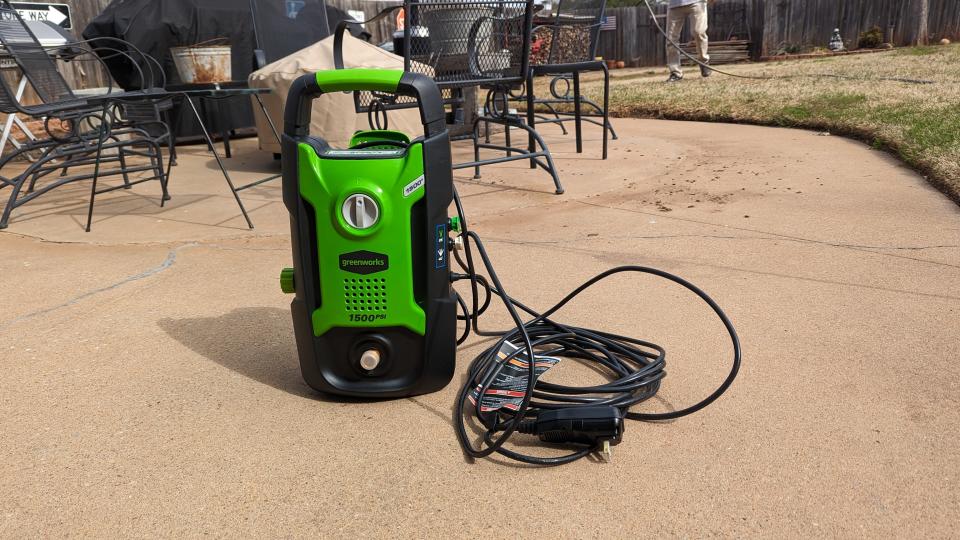
When we were ready to use one of the quick connecter tips, we removed it from the side of the pressure washer. From there, we pulled down the quick-connect collar on the spray wand and fit the tip onto it before releasing the collar.
When we tested the soap dispenser, we unlocked the front part of the spray wand by turning it counterclockwise. Doing this is a little difficult, so we advise wearing gloves so it doesn’t hurt your hands. From there, we fitted the connector of the soap bottle to the wand and turned clockwise until the tabs clicked into place.
We used an outdoor extension cord the first time we tested the pressure washer because the electric cord was not long enough. We had no issues with the extension cord.
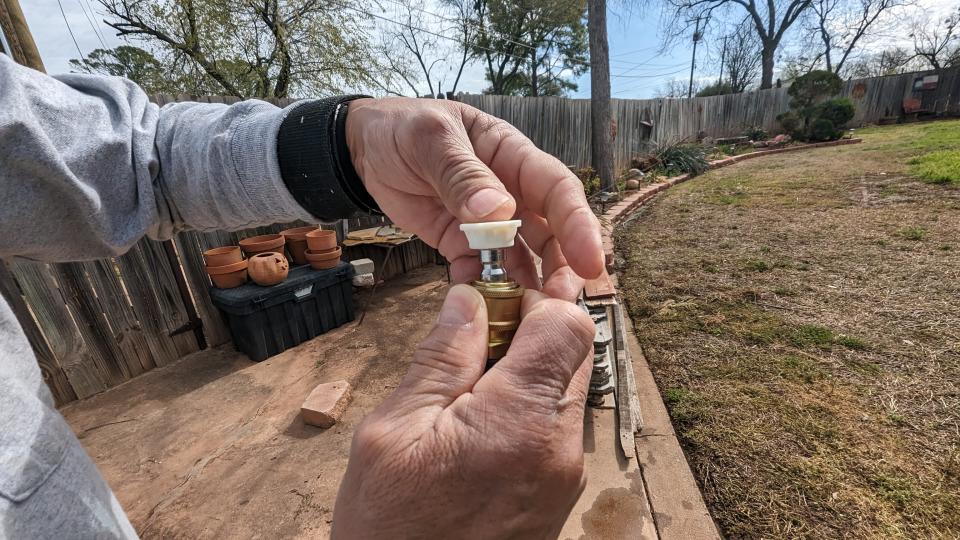
Greenworks GPW1501 Pressure Washer: Performance
As we’ve mentioned, we were pretty impressed by how well the Greenworks GPW1501 1500 PSI 1.2 GPM Pressure Washer worked. When we turn the pressure washer on, it’s not too noisy. The cord and the hose did get tangled quite a few times, but perhaps the more we use the pressure washer, the better we can keep these items untangled.
Now, the important part – how well did the pressure washer clean? We tested the pressure washer on a muddy sidewalk, a concrete porch covered in algae, moss, and grime, a wrap-around wooden porch, outdoor furniture, concrete and rock steps, and dirty bricks with some moss growth. Overall, we were very impressed by how well it did.
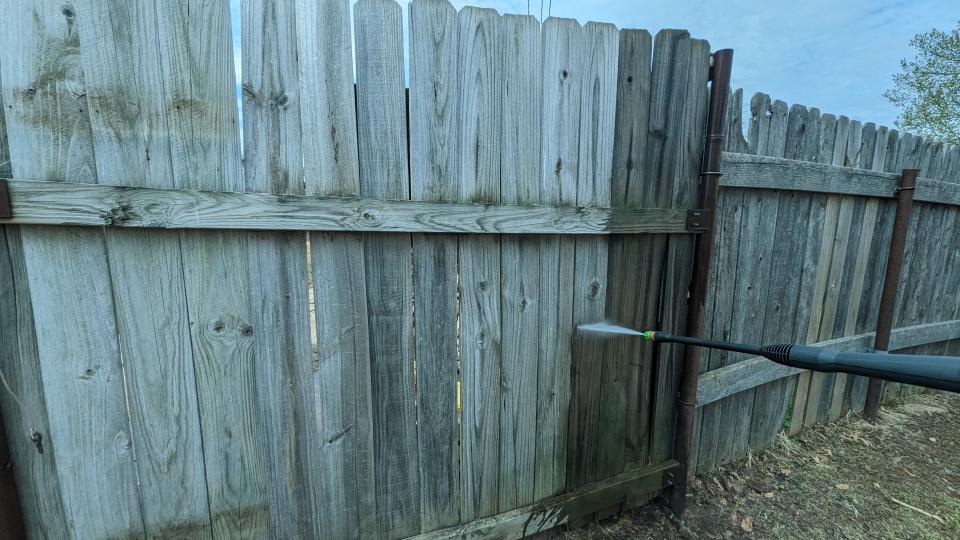
Even with a 1500 PSI, the pressure washer cut through moss, algae, dirt, and mud amazingly. It did take a bit longer than we would have liked, and this is likely since the pressure washer has only a 1.2 GPM, and we had to use a narrow-angle tip for tough jobs. Once we got in the groove, it was fun to see concrete go from dark gray to a light cream color and moss and algae be removed from bricks. We were incredibly happy that the pressure washer didn’t strip any paint from our wooden front porch. When we used it on woven wood furniture, it did a good job removing dirt from places we’d never get to with a rag.
We highly preferred using the pressure washer without the soap dispenser. Not only was it a hassle to put on, but the soap didn’t spray out very well or far and even leaked around the edges of the bottle. We didn’t see any difference between using and not using the soap. It was far easier not to connect the soap bottle.
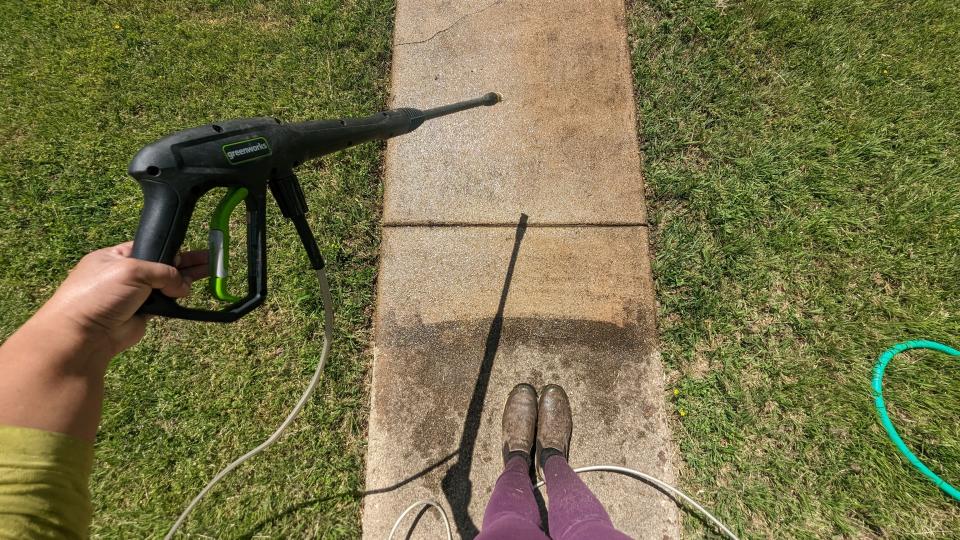
We noticed a few things during our testing that we think are important to point out. The spray wand is a bit short, and even at 5’5”, we found that our neck, shoulders, and lower back hurt a bit because we had to lean over as we cleaned porches and sidewalks to get the wand close enough to the surface to cut through the tough grime. Perhaps a higher PSI or longer wand would have prevented this.
We also used this pressure washer on three different spigots. One of the spigots we discovered had lower water pressure than the other two. It was incredibly noticeable when we connected the garden hose to that spigot and the pressure washer. The water did not come out as strong. So even with a 1500 PSI and 1.2 GPM, we wanted to make sure to note that unless your spigot produces high water pressure, it’s unlikely that this pressure washer will perform as well as it should.
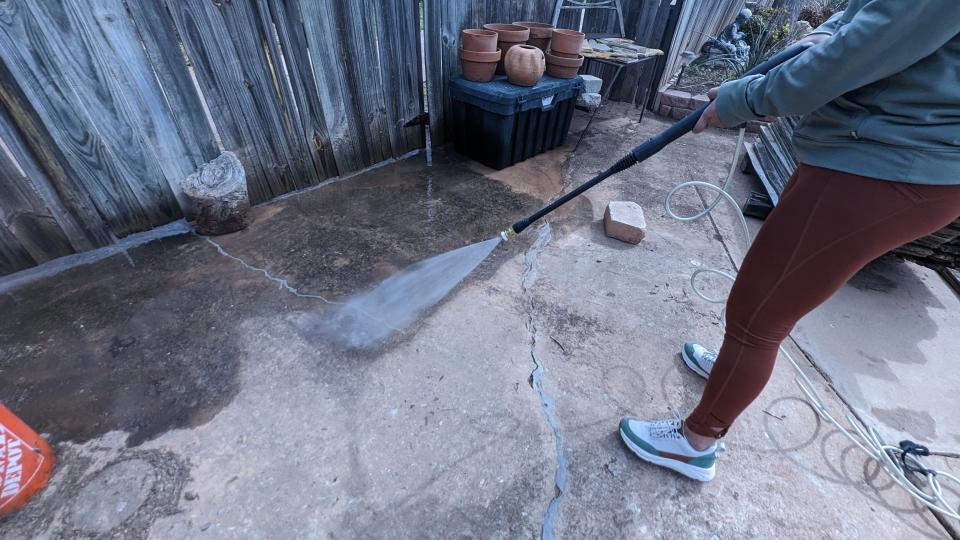
Greenworks GPW1501 Pressure Washer: Care and maintenance
The GPW1501 1500 PSI 1.2 GPM Pressure Washer is super compact, so it doesn’t take up much space when storing it away. Roll up the hose and the electric cord, break down the wand, and place it in the basket in the back of the pressure washer. You could store it in a garage corner, on a shelf, or under your bed. Do not store it outside during the winter.
Before we stored the pressure washer, we washed it off as it got muddy and dirty while cleaning around the house. There really isn’t much maintenance needed in relation to the pressure washer. If you use pressure washer detergents (and not laundry detergent or dish soap) and clean the nozzle with a straight paper clip or cleaning tool occasionally, it should work well for years.
Greenworks offers a three-year limited warranty for this pressure washer. This means that they’ll repair or replace any defective parts or materials due to workmanship or through normal use.
Greenworks GPW1501 Pressure Washer: Price and availability
A budget pressure washer that costs $99.99
The Greenworks GPW1501 1500 PSI 1.2 GPM pressure washer is considered a budget pressure washer. It typically costs $99.99 but is currently on sale for $84.99 on Amazon. Buyers can also find it on the Greenworks website.
The Greenworks GPW1501 1500 PSI 1.2 GPM pressure washer is priced accurately, but you could probably find something about the same price, if no more than $30, with more additional connect tips or a better PSI and GPM.
For instance, Homdox has a pressure washer for sale for $99.99 on Amazon. It has better PSI (1800), GPM (1.8), and five quick connect tips. Sun Joe’s SPX1050 electric pressure washer has a 1500 PSI, but three quick connect tips and 1.58 GPM. It’s usually $119 but is on sale for $86.12.
Greenworks GPW1501 Pressure Washer: User reviews
Of the 565 ratings, customers have given this pressure washer a 4.3 out of 5-star rating on Amazon. For the most part, customers are satisfied with this pressure washer and understand that it’s not the strongest pressure washer on the market but does a good job with their household cleaning needs. Reviewers noted that the PSI was a good choice and did not strip furniture or decks with proper paint jobs. While they loved how lightweight and easy it is to move around, many noted how the cord, hose, and garden hose got tangled a few times.
Many reviewers used the pressure washer on their car, noting that it didn’t cause any damage. Some pointed out that some dirt was left on their cars, but as one reviewer wrote, “I'm sorry, but no power washer can get dirt off the car without stripping paint. No matter what, your car needs a good hand wash after every other wash. Rather be safe than sorry -- stick with the lower psi.”
There was some feedback in terms of the design. One reviewer wrote, “It would be nice if there were a trigger lock of some sort, as both my hands and arms were very sore after doing my whole porch, but I got over that when I saw how clean and pretty it turned out.”
Another pointed out how the length of the spray wand could be longer: “My issues with this are the gun is too short, and I am 5'7;" at the end of wash day, my back hurts by standing up and bending over.” Many reviewers wished that the soap dispenser was better, too.
Greenworks GPW1501 Pressure Washer: Experts say
Ryan Murphy is the Director of Product Management at Greenworks, so he knows a thing or two about the Greenworks GPW1501 1500 PSI 1.2 GPM Pressure Washer. According to Murphy, this pressure washer is best for light-duty projects such as cleaning a vehicle, BBQ grill, patio furniture, and a small porch or patio. He also notes that its condensed size makes it a good choice for those with limited storage space.
Once you get your pressure washer, he advises, “Users should always unwrap the power cord and hoses to avoid tangling. Always run water through the system after connecting all hoses; i.e., turn on the water (do not start), pull the trigger on the handle to let the water push any air out of the pump, and then start your unit.”
Murphy also suggests that users get a pump saver to help the pressure washer last longer. A pump saver cleans “moisture and air out of the pump and lubricates it when storing during colder winter months to avoid corrosion and pumps cracking.”
If users should ever have an issue, Murphy would guide them to the Greenworks website. “With electric pressure washers, you don’t have to deal with engines and the problems that come with them. [However,] our website has a good FAQ section, and the product manual also has a section that outlines simple troubleshooting,” he says. “If they can’t easily navigate this, we have customer support lines that can help.”
According to Murphy, beyond the initial price of buying this Greenworks pressure washer, users won’t be spending too much money to clean their homes.
He says, “Energy cost per kWh is around $0.10-$0.12, which would cost the end user roughly $0.30 to pressure wash for 2 hours. If you use it three times per year at two hours per use, the total cost for energy consumption is about $1, plus $3/year for a pump saver ($9 overall), and it will only cost you $4 per year to operate and protect your investment.”
Should you buy the Greenworks GPW1501 Pressure Washer?
We were very happy with how well the Greenworks GPW1501 1500 PSI 1.2 GPM Pressure Washer cleaned our patios, sidewalks, porch, and furniture. Considering how affordable this pressure washer is, we can overlook the average soap bottle design and how the cords and hoses can get tangled. This pressure washer is so easy to set up and move around, and it did a bang-up job on algae, dirt, grime, mud, and moss on tough surfaces like concrete, stone, and brick. And it never stripped the paint off our wooden house!
While it may take a little longer to get the cleaning job done because of the lower PSI and GPM, there are easy ways to work around this – like doing one cleaning job daily rather than all at once. The Greenworks GPW1501 1500 PSI 1.2 GPM Pressure Washer will satisfy most homeowners and is a smart buy.
How does the Greenworks GPW1501 Pressure Washer compare?
Compared to competitors, the Greenworks GPW1501 1500 PSI 1.2 GPM Pressure Washer holds its own in certain aspects, especially in price. As we’ve seen, it does a great job, but if you’re willing to spend about $20-$60 more, you could get a heavier-duty pressure washer.
Consider three budget electric pressure washers, starting with the SunJoe SPX3000. It is more expensive at $169, but it has a 2030 Max PSI and a 1.76 GPM, which means you’ll be able to cut through tougher grime and clean faster. We also like that it has 5 quick connect tips, wheels, and detergent tanks connected to the pressure washer.
The Rock&Rocker pressure washer is like the Greenworks GPW1501 in that it has an attachable soap bottle but a better PSI (2150) and GPM (2.6), plus four quick connect nozzles. Wheels make it easier to move around, too. Like the SunJoe, it is more expensive at $146.
Craftsman's Electric Pressure Washer is the most similar pressure washer to the Greenworks GPW1501. The PSI may be 1700, but the GPM is only 1.2, and the soap bottle is attachable. Both weigh about the same, and the Craftsman is only $109. It has a slightly higher rating at 4.4 out of 5 stars on Amazon.

